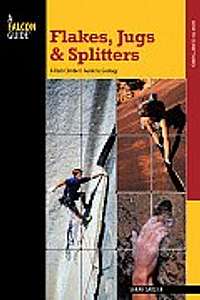Flakes, Jugs, and Splitters
In Flakes, Jugs, and Splitters: A Rock Climber’s Guide to Geology, she sets forth the basics of plate tectonics and rock formation and then delves into the geological history of popular climbing destinations on all seven continents.
Garlick seems to understand that many people find geology a dry and difficult subject, and she does her best to make it accessible to the ordinary reader. She is helped in this task by the color charts, tables, and photographs that fill the book. On a few occasions, however, she slips into scientific language that is hard for a non-specialist to follow.
Most of the book is devoted to answering questions about specific rock-climbing sites. Such as “Why is the Red River Gorge so steep?” and “Why are there big walls in Zion?” and “Why is there good bouldering in Bishop?” and "Why is the Yellow Band on Mount Everest?" In her answers, Garlick often expounds on the broader geological history of a place.
Garlick devotes seven chapters to climbing sites in the United States and Canada. To list just some: Cathedral Ledge in New Hampshire, the Shawangunks in New York, Red River Gorge in Tennessee, the Needles in South Dakota, the Bugaboos in Alberta, and Hueco Tanks in Texas. She devotes one chapter to each of the other six continents.
One can understand Garlick’s wish to be comprehensive and cover the whole world. The downside is that climbers who have no intention of visiting Baffin Island, say, may wish that she had devoted more space to crags closer to home. As a resident of the Adirondacks, I was disappointed that she ignored our region entirely.
The book’s other shortcoming is that it lacks a glossary to help readers keep track of the many scientific terms.
Such criticisms notwithstanding, Garlick’s book should appeal to any climbers who are at all curious about the natural forces that made their sport possible.
Softcover, 212 pages, $17.95
Amazon


